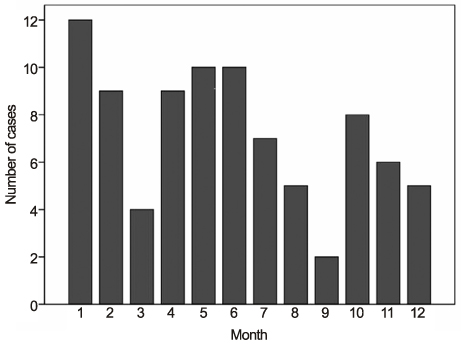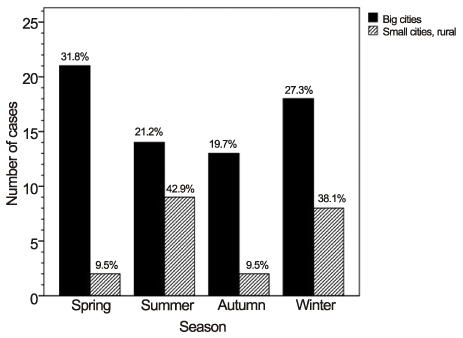J Korean Ophthalmol Soc.
2012 Nov;53(11):1637-1641.
Seasonal Variations of Acute Angle-Closure Glaucoma in Patients Visiting the Hospital
- Affiliations
-
- 1Cheil Eye Hospital, Daegu, Korea. eye7575@korea.com
Abstract
- PURPOSE
The present study investigates the seasonal variations of acute angle-closure glaucoma in patients visiting the hospital.
METHODS
Eighty-seven patients (94 eyes) who underwent laser iridotomy were retrospectively analyzed over 5 years. Monthly and seasonal variations were investigated and the difference in seasonal variations according to sex, age, and inhabited area were inspected.
RESULTS
When evaluating monthly variations, acute angle-closure glaucoma occurred mostly in January (13.8%). Incidence of glaucoma was the highest in winter (29.9%), decreased in spring and summer (26.4%) and was lowest in autumn (17.2%). In big cities, the incidence trend was highest in spring (31.8%), lowest in autumn (19.7%) and slightly elevated in winter (27.3%). However, in small cities and rural areas, the incidence was highest in summer (42.9%) and winter (38.1%). There were significant differences between inhabited areas.
CONCLUSIONS
Among the patients, seasonal incidence of acute angle-closure glaucoma was the highest in winter and decreased as autumn approached. There were differences of incidence between inhabited areas.
Keyword
Figure
Reference
-
1. Shin SG, Ahn JH, Rho SH. A clinical analysis on 456 cases of glaucoma among outpatients during 5 years. J Korean Ophthalmol Soc. 1987. 28:1021–1026.2. Song GW, Jin KH, Kim JM. Clinical data on glaucomatous patients. J Korean Ophthalmol Soc. 1990. 31:1179–1183.3. Foster PJ. The epidemiology of primary angle closure and associated glaucomatous optic neuropathy. Semin Ophthalmol. 2002. 17:50–58.4. Teikari J, Raivio I, Nurminen M. Incidence of acute glaucoma in Finland from 1973 to 1982. Graefes Arch Clin Exp Ophthalmol. 1987. 225:357–360.5. David R, Tessler Z, Yassur Y. Epidemiology of acute angle-closure glaucoma: incidence and seasonal variations. Ophthalmologica. 1985. 191:4–7.6. Tupling MR, Junet EJ. Meteorological triggering of acute glaucoma attacks. Trans Ophthalmol Soc U K. 1977. 97:185–188.7. Seah SK, Foster PJ, Chew PT, et al. Incidence of acute primary angle-closure glaucoma in Singapore. An island-wide survey. Arch Ophthalmol. 1997. 115:1436–1440.8. Gao F, Seah SK, Foster PJ, et al. Angular regression and the detection of the seasonal onset of disease. J Cancer Epidemiol Prev. 2002. 7:29–35.9. Lai JS, Liu DT, Tham CC, et al. Epidemiology of acute primary angle-closure glaucoma in the Hong Kong Chinese population: prospective study. Hong Kong Med J. 2001. 7:118–123.10. Krupin T, Mitchell KB, Johnson MF, Becker B. The long-term effects of iridectomy for primary acute angle-closure glaucoma. Am J Ophthalmol. 1978. 86:506–509.11. Bobrow JC, Drews RC. Long term results of peripheral iridectomies. Glaucoma. 1981. 3:319–322.12. Playfair TJ, Watson PG. Management of acute primary angle-closure glaucoma: a long-term follow-up of the results of peripheral iridectomy used as an initial procedure. Br J Ophthalmol. 1979. 63:17–22.13. Foster PJ, Johnson GJ. Glaucoma in China: how big is the problem? Br J Ophthalmol. 2001. 85:1277–1282.14. Kee HS, Kim SJ, Yang KJ. Clinical study on primary acute angle closure glaucoma. J Korean Ophthalmol Soc. 1995. 36:499–504.
- Full Text Links
- Actions
-
Cited
- CITED
-
- Close
- Share
- Similar articles
-
- Correlation between Seasons, Climatic Factors and Acute Angle Closure Attack Incidence
- Biometric Comparisons between Acute and Chronic Angle Closure Glaucoma
- Long-term Follow-up Results of Glaucoma Triple Procedures in Patients with Angle-closure Glaucoma
- Argon Laser Iridotomy
- Comparison of Anterior Chamber Depth with Posture Change Between Primary and lens-induced Angle Closure Glaucomas




